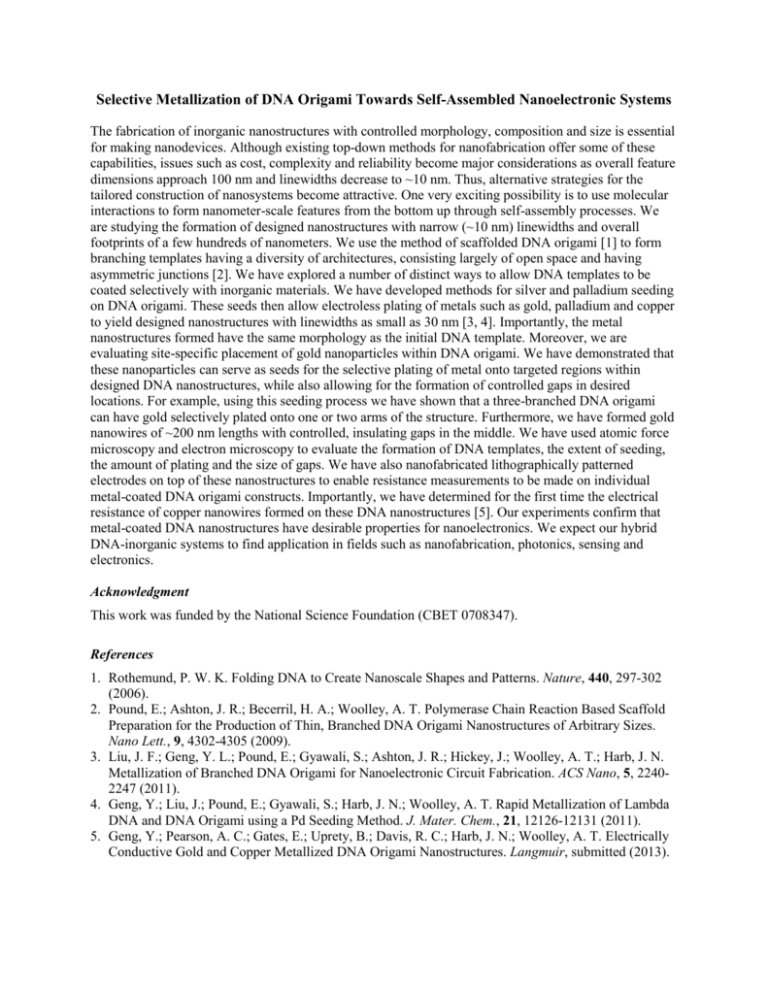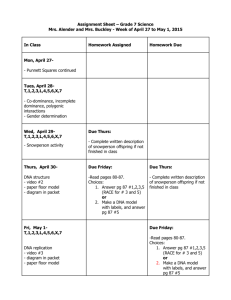Selective Metallization of DNA Origami Towards Self
advertisement

Selective Metallization of DNA Origami Towards Self-Assembled Nanoelectronic Systems The fabrication of inorganic nanostructures with controlled morphology, composition and size is essential for making nanodevices. Although existing top-down methods for nanofabrication offer some of these capabilities, issues such as cost, complexity and reliability become major considerations as overall feature dimensions approach 100 nm and linewidths decrease to ~10 nm. Thus, alternative strategies for the tailored construction of nanosystems become attractive. One very exciting possibility is to use molecular interactions to form nanometer-scale features from the bottom up through self-assembly processes. We are studying the formation of designed nanostructures with narrow (~10 nm) linewidths and overall footprints of a few hundreds of nanometers. We use the method of scaffolded DNA origami [1] to form branching templates having a diversity of architectures, consisting largely of open space and having asymmetric junctions [2]. We have explored a number of distinct ways to allow DNA templates to be coated selectively with inorganic materials. We have developed methods for silver and palladium seeding on DNA origami. These seeds then allow electroless plating of metals such as gold, palladium and copper to yield designed nanostructures with linewidths as small as 30 nm [3, 4]. Importantly, the metal nanostructures formed have the same morphology as the initial DNA template. Moreover, we are evaluating site-specific placement of gold nanoparticles within DNA origami. We have demonstrated that these nanoparticles can serve as seeds for the selective plating of metal onto targeted regions within designed DNA nanostructures, while also allowing for the formation of controlled gaps in desired locations. For example, using this seeding process we have shown that a three-branched DNA origami can have gold selectively plated onto one or two arms of the structure. Furthermore, we have formed gold nanowires of ~200 nm lengths with controlled, insulating gaps in the middle. We have used atomic force microscopy and electron microscopy to evaluate the formation of DNA templates, the extent of seeding, the amount of plating and the size of gaps. We have also nanofabricated lithographically patterned electrodes on top of these nanostructures to enable resistance measurements to be made on individual metal-coated DNA origami constructs. Importantly, we have determined for the first time the electrical resistance of copper nanowires formed on these DNA nanostructures [5]. Our experiments confirm that metal-coated DNA nanostructures have desirable properties for nanoelectronics. We expect our hybrid DNA-inorganic systems to find application in fields such as nanofabrication, photonics, sensing and electronics. Acknowledgment This work was funded by the National Science Foundation (CBET 0708347). References 1. Rothemund, P. W. K. Folding DNA to Create Nanoscale Shapes and Patterns. Nature, 440, 297-302 (2006). 2. Pound, E.; Ashton, J. R.; Becerril, H. A.; Woolley, A. T. Polymerase Chain Reaction Based Scaffold Preparation for the Production of Thin, Branched DNA Origami Nanostructures of Arbitrary Sizes. Nano Lett., 9, 4302-4305 (2009). 3. Liu, J. F.; Geng, Y. L.; Pound, E.; Gyawali, S.; Ashton, J. R.; Hickey, J.; Woolley, A. T.; Harb, J. N. Metallization of Branched DNA Origami for Nanoelectronic Circuit Fabrication. ACS Nano, 5, 22402247 (2011). 4. Geng, Y.; Liu, J.; Pound, E.; Gyawali, S.; Harb, J. N.; Woolley, A. T. Rapid Metallization of Lambda DNA and DNA Origami using a Pd Seeding Method. J. Mater. Chem., 21, 12126-12131 (2011). 5. Geng, Y.; Pearson, A. C.; Gates, E.; Uprety, B.; Davis, R. C.; Harb, J. N.; Woolley, A. T. Electrically Conductive Gold and Copper Metallized DNA Origami Nanostructures. Langmuir, submitted (2013).






